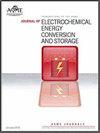Experimental Studies of Graphene-Coated Polymer Electrolyte Membranes for Direct Methanol Fuel Cells
IF 1.9
4区 工程技术
Q3 ELECTROCHEMISTRY
Journal of Electrochemical Energy Conversion and Storage
Pub Date : 2022-11-17
DOI:10.1115/1.4056269
引用次数: 2
Abstract
The two main technical limitations of direct methanol fuel cells (DMFCs) are the slow kinetic reactions of the methanol oxidation reaction (MOR) in the anode and the crossing over of unreacted methanol through the proton exchange membrane (PEM). It is common practice to use Nafion membranes as PEMs, which have high ion exchange capacity. However, Nafion-based membranes also have high fuel permeability, decreasing fuel utilization and reducing the potential power density. This manuscript focuses on using graphene-coated (Gr-coated) PEMs to reduce fuel crossover. Protons can permeate across graphene and thus it can be employed in various devices as a proton conductive membrane. Here we report efficiency of Gr-coated Nafions. We tested performance and crossover at three different temperatures with four different fuel concentrations and compared to a Nafion PEM that underwent that same test conditions. We found that the adhesion of Gr on to PEMs is not sufficient for prolong fuel cell operation resulting in Gr delamination at high temperatures leading to a higher fuel crossover values compared to lower temperature testing. The results for 7.5M methanol fuel show a reduction of up to 25% in methanol crossover, translating to a peak power density that increases from 3.9 to 9.5 mW/cm2 when using a Gr-Coated PEM compared to a Nafion PEM at 30°C.直接甲醇燃料电池用石墨烯包覆聚合物电解质膜的实验研究
直接甲醇燃料电池(dmfc)的两个主要技术限制是阳极甲醇氧化反应(MOR)的缓慢动力学反应和未反应的甲醇通过质子交换膜(PEM)的交叉。使用Nafion膜作为pem是一种常见的做法,它具有很高的离子交换能力。然而,基于nafion的膜也具有高燃料渗透率,降低了燃料利用率并降低了潜在的功率密度。本文的重点是使用石墨烯涂层(Gr-coated) PEMs来减少燃料交叉。质子可以穿透石墨烯,因此它可以作为质子导电膜应用于各种设备中。在这里,我们报告了镀铬合金的效率。我们在三种不同的温度和四种不同的燃料浓度下测试了性能和跨界性能,并与在相同测试条件下测试的Nafion PEM进行了比较。我们发现,与低温测试相比,石墨烯在PEMs上的粘附不足以延长燃料电池的运行时间,导致在高温下石墨烯分层,从而导致更高的燃料交叉值。750米甲醇燃料的结果显示,与30°C下使用的Nafion PEM相比,使用gr涂层PEM时,甲醇交叉减少了25%,转化为峰值功率密度从3.9 mW/cm2增加到9.5 mW/cm2。
本文章由计算机程序翻译,如有差异,请以英文原文为准。
求助全文
约1分钟内获得全文
求助全文
来源期刊

Journal of Electrochemical Energy Conversion and Storage
Engineering-Mechanics of Materials
CiteScore
4.90
自引率
4.00%
发文量
69
期刊介绍:
The Journal of Electrochemical Energy Conversion and Storage focuses on processes, components, devices and systems that store and convert electrical and chemical energy. This journal publishes peer-reviewed archival scholarly articles, research papers, technical briefs, review articles, perspective articles, and special volumes. Specific areas of interest include electrochemical engineering, electrocatalysis, novel materials, analysis and design of components, devices, and systems, balance of plant, novel numerical and analytical simulations, advanced materials characterization, innovative material synthesis and manufacturing methods, thermal management, reliability, durability, and damage tolerance.
 求助内容:
求助内容: 应助结果提醒方式:
应助结果提醒方式:


